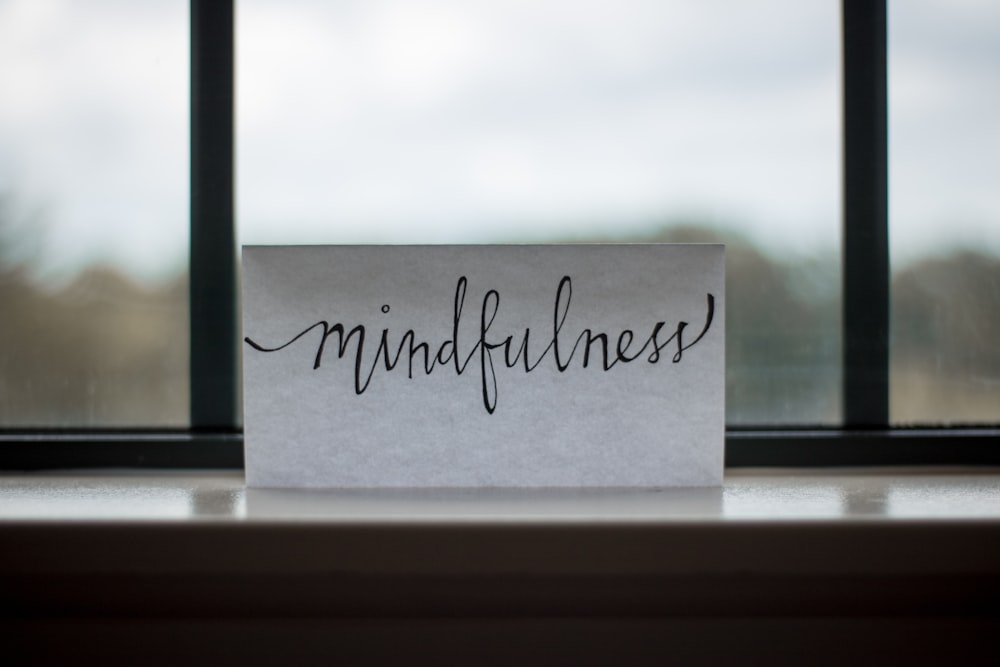Cover photo by Gabriel Bastelli from Pexels
Written by Aubrey Hartshorn
Mindfulness is a pretty trendy word these days, but what exactly is mindfulness? And how can it help us in our marriages?
What is Mindfulness?
Dr. John Kabat-Zinn defines mindfulness as an “awareness that arises through paying attention, on purpose, in the present moment, non-judgmentally” (Kabat-Zinn, 1994). To be mindful is to be conscious and deliberate about your life. It is about choosing to be where you are, to really be present in the moment. It is natural for our minds to get caught up in a cycle of living in the past or the future, with little attention to the present. Being mindful is a reminder to slow down and appreciate the beauty of where you are right now.

A wide spectrum of research has highlighted benefits of living mindfully. Some of the benefits include decreased stress, improved focus, greater immune functioning, lower anxiety, and improved overall well-being (Davis & Hayes, 2012). In relationships, practicing mindfulness has been shown to improve communication, decrease emotional reactivity, increase empathy, and heighten relationship satisfaction (Gambrel & Keeling, 2010). These benefits come by consciously being present; choosing to be awake and aware of what is now.
Turning Off Autopilot
We have all had the experience of arriving at our destination without having been fully conscious of the roads we were taking. Perhaps your mind was scanning over your mental to-do list, ruminating on a recent conflict with a partner or co-worker, or making plans for tomorrow. Suddenly you arrive at home or your office without having been fully aware of the route you took, lights you stopped at, or other drivers who passed by. This is called autopilot.

This phenomenon of living on autopilot not only happens when driving, but can also be present in our relationships. When life gets busy, sometimes our marriages can get pushed to the back-burner. Date nights become few and far between, late night heart-to-heart talks turn into a quick “goodnight,” before hitting the pillow, and greetings turn into a halfhearted peck before quickly moving on to complete some other task. These small actions of not “being present” can lead our relationship to grow stagnant over time. Mindfulness is an invitation to combat autopilot, to see your partner and your relationship with fresh eyes, and to sincerely give them your time and attention. As Dr. Mark Williams explained, “[mindfulness] allows you to look at the world once again with open eyes. And when you do so, a sense of wonder and quiet contentment begins to reappear in your life” (Williams & Penman, 2011).
Presence in Practice
You do not need to go meditate on a mountaintop, perfect your handstand in yoga, or light candles and chant “ommm” in order to be more mindful. Simply bring your attention to what you are doing now. When your partner is talking to you, really listen. When you are hugging your spouse, really hug them. Along with your physical presence, give your partner the gift of your mental and emotional presence. When you find yourself on autopilot or your attention is drifting from the present moment, simply focus on your breathing as a gentle reminder to bring your awareness back.
Here are a few simple ways to actively incorporate more mindfulness into your marriage:
1. Mindful Embrace
Hugging has been shown to have many health benefits including greater immunity against illness, decreased stress, reduced anxiety, and increased optimism (Miller, 2017). Taking your partner in your arms in a mindful embrace is a wonderful way to reconnect with him or her at the end of the day. In order to practice a mindful embrace, stand facing your partner. Gently supporting your own weight, take each other in a loose embrace. There is no need to talk during this embrace, rather focus on simply being present with your partner. Synchronizing your breathing with that of your partner, deeply inhale and slowly exhale. Repeat at least three times, longer if desired. Notice how you feel in your partner’s arms. Pay attention to any bodily sensations you may be experiencing. Gently, and without judgment, recognize any thoughts going through your mind and allow them to calmly pass. Softly coming out of the hug, face each other and take a moment to share any impressions or feelings you had during the embrace.

2. Mindful Walking
Sometimes communicating with your partner in a positive way is easier when you are doing an activity together. Before taking your walk, decide on a topic that you want to sort out. Perhaps it is a financial concern, topic of conflict in your relationship, or opportunity to ask one another what you can improve on. As you begin your walk, find a comfortable pace and walk side by side with your partner. Try to soften any tight muscles and relax into the rhythm of your breath. After about ten minutes of silently walking side by side, open a gentle dialogue of the topic you established beforehand. Strive to continue breathing slowly and deeply. As you walk, do your best to listen with an open heart to what your partner shares. Give each other the gift of acceptance and non-judgement. After the walk, take a moment for a mindful embrace.
3. Mindful Listening
Mindfulness has been shown to decrease relational conflict and improve positive communication (Barnes et al., 2007). These benefits happen in part because mindfulness helps us to be more present in the moment of the conversation, to react with less emotionality, and to truly hear what our partner is sharing. To practice mindful listening, give your partner your full attention next time they start a conversation with you. Begin by clearing away any distractions, perhaps turning off your cell phone. Take a few deep breaths to clear your mind, allowing for greater mental space to hear what your partner would like to share. As your partner speaks, listen carefully. Rather than focusing on your response, strive to allow what he or she is saying to really enter into your heart. Do your best to see the situation from their perspective, without judgment. Be aware of your non-verbal communication as well, communicating to them with your eye contact and an open posture that they have your full attention. Appreciate the clarity and calm this type of communication can bring to your relationship. (Read more from us on listening here)

In Conclusion
Mindfulness is an innate ability deep within each of us. Unfortunately, it sometimes gets pushed away in this fast-paced world. By putting in the practice and effort to truly be present, the ability to be mindful will become more natural. As we become more mindful, our relationships with ourselves and our partners will flourish. In the words of Zen Master Thich Nhat Hanh, “the most precious gift we can offer others is our presence. When mindfulness embraces those we love, they will bloom like flowers.”
References
Barnes, S., Brown, K.W., Krusemark, E., Campbell, W. K., & Rogge, R. D. (2007). The role of mindfulness in romantic relationship satisfaction and responses to relationship stress. Journal of Marital and Family Therapy 33(4), 482-500.
Davis, D. M., & Hayes, J. A. (2012) What are the benefits of mindfulness? A practice review of psychotherapy-related research. Psychotherapy, 48(2), 198-208.
Gambrel, L. E., & Keeling, M. L. (2010). Relational aspects of mindfulness: Implications for the practice of marriage and family therapy. Contemporary Family Therapy, 32(4), 412-426.
Kabat-Zinn, J. (1994). Wherever You Go There You Are. New York, NY: Hachette Books.
Miller, J. (2017). 20 Amazing Benefits of Hugging According to Science. Retrieved from https://www.jenreviews.com/hugging/
Williams, M., & Penman, D. (2011). Mindfulness: An Eight-Week Plan for Finding Peace in a Frantic World. New York, NY: Rodale Books.


